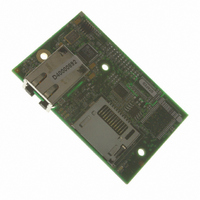20-101-1139 Rabbit Semiconductor, 20-101-1139 Datasheet - Page 45

20-101-1139
Manufacturer Part Number
20-101-1139
Description
RCM4310 RABBITCORE
Manufacturer
Rabbit Semiconductor
Datasheet
1.20-101-1139.pdf
(124 pages)
Specifications of 20-101-1139
Module/board Type
MPU Core Module
Product
Microcontroller Modules
Data Bus Width
8 bit
Core Processor
Rabbit 4000
Clock Speed
58.98 MHz
Interface Type
Ethernet
Flash
1 MByte
Timers
10 x 8 bit
Operating Supply Voltage
3.3 V
Board Size
72 mm x 47 mm x 21 mm
For Use With/related Products
RCM4310
Lead Free Status / RoHS Status
Lead free / RoHS Compliant
Other names
316-1142
Available stocks
Company
Part Number
Manufacturer
Quantity
Price
4.6 Memory
4.6.1 SRAM
All RCM4300 modules have 512K of battery-backed data SRAM installed at U10, and the
RCM4300 model has 512K of fast SRAM installed at U12.
4.6.2 Flash Memory
All RCM4300 modules also have up to 2MB of serial flash memory installed at U5.
A “user block” area is defined to store persistent data. The functions writeUserBlock
and readUserBlock are provided for this. Refer to the
Designer’s Handbook
4.6.3 VBAT RAM Memory
The tamper detection feature of the Rabbit 4000 microprocessor can be used to detect any
attempt to enter the bootstrap mode. When such an attempt is detected, the VBAT RAM
memory in the Rabbit 4000 chip is erased. The serial bootloader on RCM4300 RabbitCore
modules uses the bootstrap mode to load the SRAM, which erases the VBAT RAM mem-
ory on any reset, and so it cannot be used for tamper detection.
4.6.4 microSD™ Cards
The RCM4300 supports a removable microSD™ Card up to a 1 GB to store data and Web
pages. The microSD™ Card is particularly suitable for mass-storage applications, but is
generally unsuitable for direct program execution.
Unlike other flash devices, the microSD™ Card has some intelligence, which facilitates
working with it. You do not have to worry about erased pages. All microSD™ Cards sup-
port 512-byte reads and writes, and handle any necessary pre-erasing internally.
Figure 14 shows how to insert or remove the microSD™ Card. The card is designed to fit
easily only one way — do not bend the card or force it into the slot. While you remove or
insert the card, take care to avoid touching the electrical contacts on the bottom of the card
to prevent electrostatic discharge damage to the card and to keep any moisture or other
contaminants off the contacts. You will sense a soft click once the card is completely
inserted. To remove it, gently press the card towards the middle of the RCM4300 — you
will sense a soft click and the card will be ready to be removed. Do not attempt to pull the
card from the socket before pressing it in — otherwise the ejection mechanism will get
damaged. The ejection mechanism is spring-loaded, and will partially eject the card when
used correctly.
RabbitCore RCM4300 User’s Manual
NOTE: When using the optional Dynamic C FAT file system module, do not remove or
insert the microSD™ Card while LED DS4 above the
cate that the
Card
is unmounted, indicating that it is safe to remove it.
for additional information.
microSD™ Card
is mounted. The LED will go off when the
Rabbit 4000 Microprocessor
microSD™ Card
is on to indi-
microSD™
45


















